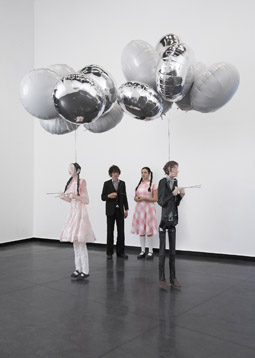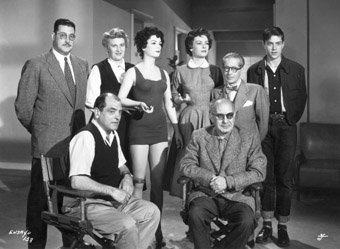in the loop
realtime news & advance word

Simon Yates, Rhabdomancy 2009, NEW09
courtesy the artist
Simon Yates, Rhabdomancy 2009, NEW09
realtime: archive update
The complete RealTime editions of 2002 have now been added to our easily accessed online archive. We’re gradually working our way back to 1994, covering a period of astonishing inventiveness and hybridity.The archive is great for an informal browse and likely to revive faded memories and jolt recollection of many more. It’s also invaluable for research. A chance browse took me immediately to Jacqueline Millner’s December 2002 article about leading Australian performance artist Barbara Campbell who, coincidentally has written in our current edition about her recent trip to New York to see the exhibitions celebrating the work of a performance artist who inspired her, Tehching Hsieh. www.realtimearts.net/archive
acca: new09
In a RealTime issue brimming with news and information by, about or for young artists, here’s some more. Since 2002 ACCA has extended a supportive hand to the young and emerging in the form of their annual NEW exhibition. In this, the inaugural year of their partnership with the Balnaves Foundation ($300,000 over three years) ACCA has commissioned seven new works from eight selected artists. NEW09 is curated by Charlotte Day with artists displaying a range of artform crossovers. Justine Khamara works with photography and portraiture, cutting up photographic prints and re-composing sculpturally. Given her environmental concerns, Brodie Ellis filmed the ‘morning glory’ cloud formations of Burketown for her contribution to NEW. Marco Fusinato has created a sculpture “that draws on the aesthetics and spectacular effects of the concert stage.” Simon Yates makes life-sized animated robots from balsa wood and paper. (See photo below. A couple of his constructions are currently making their way through the ACCA galleries. See also The robot that looked like me on YouTube). Matthew Griffin “treads a thin line between black-humour, slapstick comedy and pathos with his low-fi assemblages, videos and photography.” Benjamin Armstrong’s glass and wax sculptures are “an extension of his ongoing sculptural and drawing based project on the world of the eye. The works will make material the act of looking, searching or gazing.”
NEW09, ACCA, Melbourne, till May 17
synaesthesia
Meanwhile, you can get your wires well and truly crossed at ACMI’s Synaesthesia, “a program of free live performances exploring the many forms of moving image, including media art, newly interpreted live film scores and works that draw on sound and film archives.” The program will feature intimate showcases from Mink Engine, Outpost Collective, Robin Fox, Abject Leader, the Ang Fang Quartet, Jean Poole with DJ CanCut, Gossip Pop, Paul Robertson and a live collaboration between Qua and Isobel Knowles, all in Studio 1 as part of Late Night Thursday’s program from April to June. The series is free and begins the first Thursday in April and runs for most Thursday nights from 6.30pm, with Happy Hour at the ACMI Lounge from 5.30pm. Does it get any better than this?
picture yourself
Well possibly. The National Portrait Gallery is encouraging young Australians between 18 and 25 to enter the National Youth Self-Portrait Prize. Entrants are invited to create a self-portrait (produced in the year preceding the prize) in any of the following two-dimensional media: drawing, printing, painting, traditional or digital still photography and screen-based media such as film, video or animation. There’s a $10,000 prize decided by a panel of three judges who’ll choose a shortlist of works for exhibition. A selection of entries, including the prize-winning work, will be displayed at the National Portrait Gallery as well as in an online exhibition from July 23-Sept 13. Entries close April 30; go to www.portrait.gov.au for online submission form.
another splendid opportunity
If you’re under 30 or in the first five years of your practice, and if you’re laterally minded and aesthetically inclined to hybrid arts, then Lismore Regional Gallery, in partnership with Splendour in the Grass music festival, NORPA and Nothern Rivers Art, has a unique offer for you. Young and emerging artists can apply to be part of Splendid. On offer there’s a seriously intensive Arts Lab (a three-week research and development residential laboratory in July 2009 for up to 10 emerging artists), an opportunity for a commision for a new artwork and the chance to market the finished version internationally. The focus is on artists with an inclination for mixing it up, whatever field you’re part of: dance, sound, design, text, visual arts, theatre, installation, architecture, digital media, community arts or something not yet labelled. The mentoring will be by leading established innovators from Australia and overseas. The participants will receive a fee, free accommodation and travel. Applications due: 4pm May 4; www.splendid.org.au

On location for The Criminal Life of Archibaldo de la Cruz. Standing: Jacinto Lasa, Jeanne Rucar, Miroslava Stern,
Jose Ignacio Mantecon and Rafael Buñuel. Seated: Luis Buñuel and Ernesto Ugarte.
México 1955
Courtesy of Centro Buñuel de Calanda
On location for The Criminal Life of Archibaldo de la Cruz. Standing: Jacinto Lasa, Jeanne Rucar, Miroslava Stern,
Jose Ignacio Mantecon and Rafael Buñuel. Seated: Luis Buñuel and Ernesto Ugarte.
México 1955
honouring buñuel
The two great Spanish Surrealists were painter Salvador Dali and filmmaker Luis Buñuel. Dali drew on the grand tradition of oil painting, distorting clocks, human bodies and nature without ever losing the sense of their literal actuality, one reason for his great popularity. Buñuel too could take the real and without visual distortion warp his narratives as if they were the stuff of dreams, sometimes with great subtlety as in Belle de Jour, or as calculated assault as in The Discreet Charm of the Bourgeoisie. Although they collaborated on two classics of Surrealist cinema, Un Chien Andalou and L’Age d’Or, the artists went their own ways, Dali into happy complicity with the Franco dictatorship. Buñuel too returned to fascist Spain where the authorities astonishingly allowed him to make a film, Viridiana, which duly scandalised government and church with its sacrilege and blasphemy and shared the Palm d’Or for Best Film at Cannes in 1961. Buñuel left Spain once again. The full version of this story can be read in the opening chapter of John Baxter’s Buñuel (Fourth Estate, London,1994). It reveals a personality operating on its own terms (friends initially thought his return to Spain a betrayal), politically driven and obsessively atheistical. Baxter quotes Orson Welles’ opinion that Buñuel was “a deeply Christian man who hates god as only a Christian can.”
The 12th Spanish Film Festival is staging a significant retrospective of the work of Buñuel who directed, wrote and edited over 30 films (including not a few very ordinary ones that kept him alive in Mexico) over his long career, including features, shorts and documentaries in Spain, France, USA and Mexico. He won awards at major international film festivals and an Academy Award and a BAFTA for The Discreet Charm of the Bourgeoisie (1972). His un-surreal Los Olvidados (The Young and the Damned, 1950) was one of the first films recognised by UNESCO in 2003 in its Memory of the World Register.
The Buñuel Retrospective includes an exhibition and panel discussions alongside 10 feature films and a documentary about the filmmaker: The Last Script—In the Memory of Buñuel (Germany, Spain, 2008), directed by Gaizka Veresti and Javier Espada, and featuring the artist’s son, Juan Luis Buñuel, a notable authority on his father’s work).
Buñuel—Amigos Y Peliculas (Friends and Films) is an exhibition of 30 portraits of friends (Salvador Dali, Federico Garcia Lorca, Max Ernst and Igor Stravinsky), family and location shots selected from the collection held at the Centro Buñuel de Calanda, Spain, Buñuel’s birthplace. The exhibition includes film posters, letters and footage of Buñuel’s anecdotes about his films. The Director and Curator of the Centro Buñuel and the co-director of the documentary about Buñuel, Javier Espada will visit Australia for the opening of the exhibition
12th Spanish Film Festival: The Bunuel Retrospective: Chauvel Cinema, Paddington, Sydney, May 6-17; National Film & Sound Archive, Canberra, May 7-13; Palace Cinema, Como, Melbourne, May 13-25; Adelaide, May 14-17; Perth, May 20-27; Brisbane, May 21-31st; Buñuel—Amigos Y Peliculas (Friends and Films), Customs House Gallery, Sydney, April 28–May 30; National Film & Sound Archive, Canberra), April 29–late Aug; City of Melbourne Library, May 2-29; www.spanishfilmfestival.com
RealTime issue #90 April-May 2009 pg. 17






